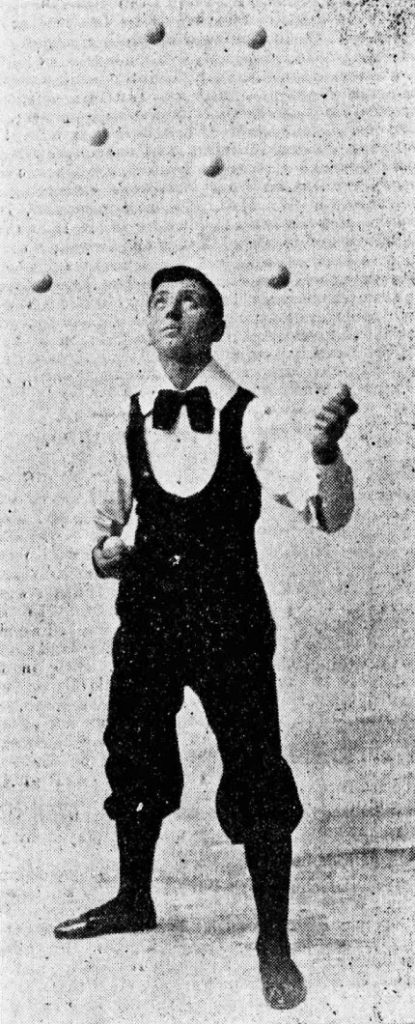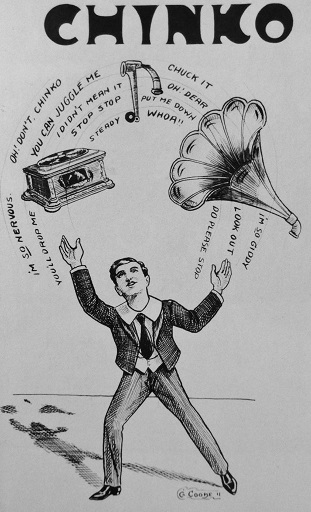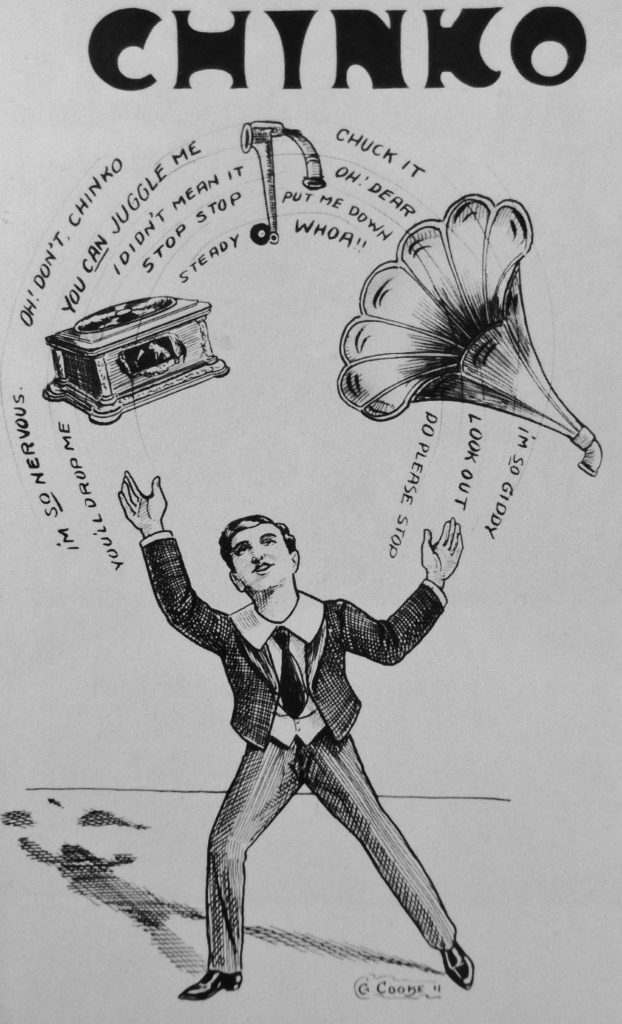Chinko was born Thomas Cromwell–Knox in England in 1880. His entire family was involved in show business. He started out performing a juggling act called The Cromwells with his brother, Teddy, who went on to become a famous comedian. When Thomas started as a solo act, he took on the stage name Chinko as a tribute to his idol, Paul Cinquevalli. The first part of Cinquevalli is pronounced “chink” and then the Japanese suffix for “child” (ko) was added.
Chinko learned to juggle using oranges. By the time he was 12, he could juggle eight balls in a multiplex pattern, tossing four pairs of billiard balls. He was able to perform a ten ball multiplex starting in 1904.
 Chinko juggling eight balls in a multiplex. Photo courtesy of Erik Aberg
Chinko juggling eight balls in a multiplex. Photo courtesy of Erik Aberg
Even as a young adult, Chinko dressed as an English school boy in his performances and was billed as “The Clever Boy Juggler”, “The Eton Boy Juggler”, “Little Chinko”, “or “”The Boy Juggler”.
Eventually these titles were dropped when he married Minnie Kaufmann of the famous Kaufmann Bicycle Troupe and could no longer pass for a school-aged boy. After marrying Minnie, the two almost always appeared on the same bill together and even integrated their skills together into one act from time to time.
 Chinko’s wife Minnie Kaufmann, the world famous trick cyclist
Chinko’s wife Minnie Kaufmann, the world famous trick cyclist
Chinko performed many common gentleman juggler tricks as well as with clubs and boomerang plates. The following is a description of his act from a performance at the Hippodrome on September 14, 1900.
“CHINKO: A combination of movements in throwing and balancing a silk hat; balancing hat on umbrella and trick movements with umbrella (closed); throwing the hat, umbrella (closed) and ball of paper, catching hat on head, then lifting hat from rear, and catching paper under hat; throwing a small table, hat, and umbrella (open); spins a basin on billiard cue (right hand), and throws a pail and a plate (left hand); throws a white top hat, umbrella, and traveling bag; throws three tea plates (inner, outer, and shower), nose movement, and three in one hand; Indian clubs, first throws and manipulates two, then kicks up a third, and throws the three (shower and back movements); throwing balls (a small size), showers five, and throws eight, four in each hand, the eight balls however are treated as four only two being handled at one time (ordinary movement); throwing four tea plates; two each hand, concluding with the boomerang plates. The performance was given in the arena, eminently suited to this latter act, which was well done and produced loud applause.”
According to juggling historian Hermann Sagemuller, Chinko “opened his act by juggling a little desk, a billiard cue, and a pair of gloves. He also juggled an open umbrella, a traveling trunk and a plate. Then he would do some marvelous tricks with clubs, five plates, lamps and burning torches. In later years he could throw up and keep in the air a gramophone key, a gramophone horn and the gramophone itself (actually playing a tune!).”
Chinko also performed Salerno’s picture frame trick, where a large framed painting is balanced on the forehead on one of its corners. The juggler bends his head slightly forward and then up, causing the picture frame to slide so as to be caught in a balance just beyond the next corner. Below is a famous photo of Chinko doing Salerno’s trick.
Chinko was talented, but never gained the fame of his contemporaries Paul Cinquevalli, Salerno, and Kara. His reviews were mixed to good, as can be seen in the following four examples.
“Chinko does some good juggling, assisted by a most boisterous boy made up as a girl. Chinko’s fault is that he sacrifices accuracy for speed. He would fare better did he take his work more quietly. He has Kara’s cue trick, which is seen for the first time since that juggler went home, and he has other good work in plenty. He should cut out the juggling of the boy. The violent efforts to make the trick appear natural spoil the effort. – Variety February 1906”
“Chinko and Company: Balancing and juggling. Time: Ten minutes. Chinko and a girl have a novelty balancing and juggling act. The girl does a bit of cycling in good fashion. Chinko juggles a few balls, balances different objects on various parts of his anatomy and displays some skill when he shoots, with a bow and arrows, paper ribbons held by his partner . A good opening act for small time describes this offering. It does not possess the unusual features of several similar turns, but is presented in a business-like manner, and in the three-a-day houses should win favor. – New York Clipper May 1919”
“Chinko, England’s juggler, was several bits nervous for the first night and it was disconcerting to have the “props” go wrong, which happened in this case. But today doubtless as fine a ten minutes of juggling as anyone could wish to see will be furnished by Chinko, whose choice of name is certainly bad. – Los Angeles Herald Sept. 1906″
“Chinko, the famous juggler from the London music halls, is another feature who will provide rare, amusement. Chinko is a wonderfully expert juggler and he introduces many laughs in his performance. – The Sunday Oregonian October 1916”
Chinko eventually moved to the U.S.A. and he and Minnie settled in New York City. It is unknown when he retired from performing. He passed away on February 28, 1943 in New York City.








